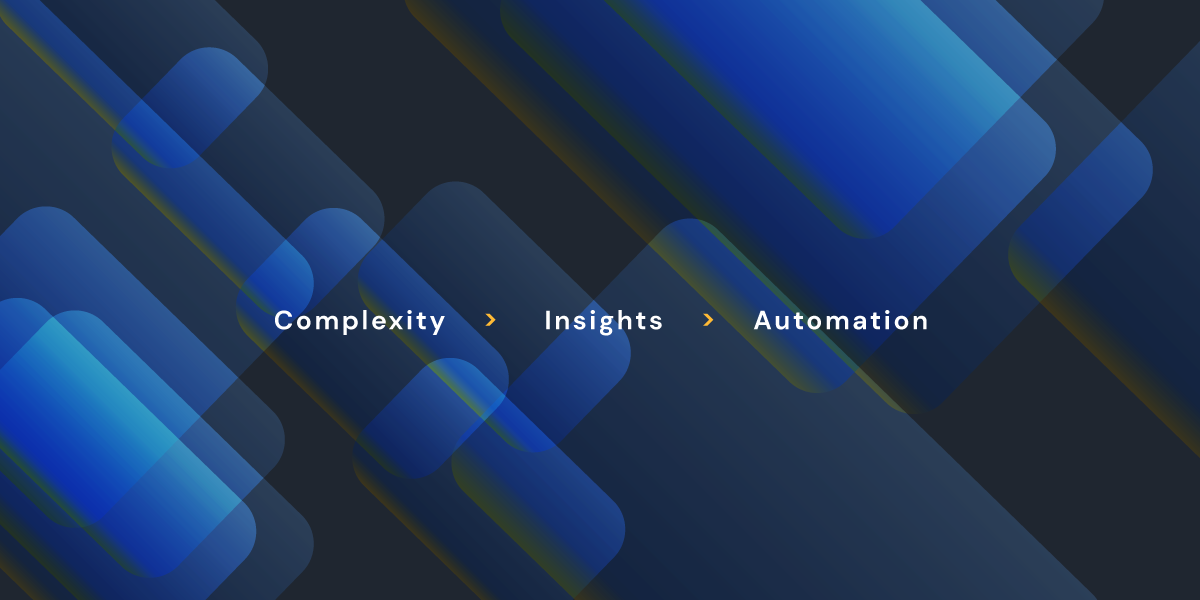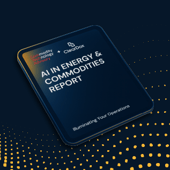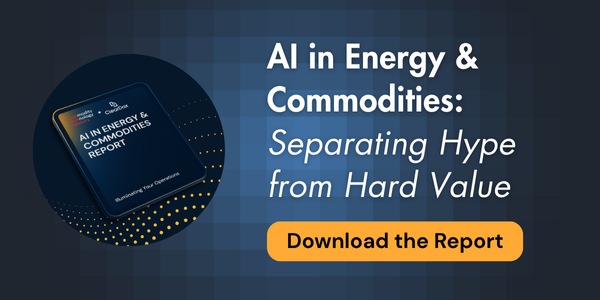How Leading Commodity Firms Are Using AI in Operations
AI is everywhere, but how useful is it to your commodities trading operations?
That's what the Commodity Technology Advisory's (CTA) "AI in Energy and Commodities" report wanted to find out.
The report, which we contributed to, cuts through the hype to examine where artificial intelligence is actually delivering results in commodity trading operations. Based on surveys, interviews, and industry analysis, the report identifies six key AI use case groups—from information services and predictive analytics to document processing and natural language system control—and evaluates their real-world penetration, benefits, and concerns.
The key finding? AI is most effective today in information processing, predictive analytics, and workflow automation. These are the areas where companies are seeing real ROI and building trust in AI systems. Meanwhile, coding assistance and full decision automation are lagging due to risk and governance concerns (which is understandable when a wrong decision can cost millions.)
Here's a look at the use cases the report covers, how they align with our mission, and what the report leaves out.
The Data Problem Every Ops Team Knows Too Well
Here's what the CTA report gets absolutely right about information services: the commodities industry is drowning in unstructured data. Your team probably deals with this reality every day—PDFs from one company, Excel files from another, and zero consistency in how anything is labeled or formatted.
“There's just vast quantities of data which are unstructured and inconsistent,” explains Stephen Epstein, Chief Marketing Officer at ClearDox. “The labeling of data is not consistent between companies. Some people send it as a PDF, some as an Excel. It's challenging for organizations to deal with, and it's required human beings in operations to manually go through all of this.”
This is where ClearDox cut its teeth, and it's still the foundation that makes everything else we do possible. But here's what's changed: automating docs-to-data conversion is becoming more commoditized. What matters now is doing it right for your specific industry.
In agriculture, you know the pain points: harvest season hits and suddenly you're drowning in truck tickets, quality certificates, and shipping documentation. Your team is under pressure just to keep up with the volume spikes.
In energy, it's different—the challenge is usually buried in contract complexity where pricing mechanisms and risk allocations can shift between execution and settlement.
What makes the difference isn't just processing this information faster (though that helps). It's being able to look at huge amounts of data and actually spot patterns. You can finally see which trucking companies consistently cause delays, or catch contract modifications before they turn into expensive disputes.
That's the power of a solution purpose-built for the commodities industry by commodities professionals.
Information Services: How AI Gets the Work Done in Ops
The CTA report hits home here. Document processing and workflow automation aren't just helpful; they're critical to operational success.
Our four intelligent applications—Operations Intelligence, Finance Optimization, Payment Processing, and Trade Confirmation—all solve the same core issue: hours of manual work keeping skilled employees from higher-value tasks.
“Too much manual work slowed us down and tied up skilled employees. We knew we had to automate,” one customer told us. But it's not just about speed. The more you automate, the more data your team can use to make important decisions.
Our Trade Confirmation application tackles a fundamental problem in commodity trading: the lack of data standards across brokers means every confirmation comes in a different format. This creates reconciliation nightmares that can hide expensive discrepancies until it's too late to fix them.
ClearDox automates trade reconciliation by comparing broker recaps, statements, and confirmations against your system of record using intuitive side-by-side views. Instead of manually cross-checking documents that might have different layouts, measurement units, or terminology, the system normalizes the data and flags discrepancies that need human attention.
We also provide real-time visibility into trade confirmation status and aging, so you can spot bottlenecks before they impact settlement. Every confirmation, comment, and resolution gets logged with a complete audit trail for compliance reporting.
Predictive Analytics: See Trouble Before It Happens
The CTA report highlights predictive analytics in areas like market and energy grid forecasting. While our focus isn't market trends, ClearDox applies the same principle to operations, spotting patterns before they become problems.
“We are able see trends,” Epstein said. “Like with demurrage delays—where are they happening? Are certain counterparties consistently responsible?”
These kinds of operational insights offer real, actionable value. If our system shows a trucking company caused delays in 8 of 10 shipments, you can take immediate steps, like adjusting scheduling, renegotiating terms, or switching partners.
Language Models and Agentic Workflows
Here's where our solution truly aligns with (and extends beyond) the CTA report's findings. The report treats AI agents as a future possibility. At ClearDox, they're already live.
ClearDox CoPilot + Agents work together to move your team seamlessly from awareness to understanding to action. Here's how they differ—and why both matter:
CoPilot is your conversational assistant, integrated into all ClearDox applications. It uses generative AI informed by your commodities documents and data to answer ad hoc questions, help make sense of discrepancies, and assist with summaries and status reporting. Operations teams can explore data naturally. They can ask questions, drill into source documents, and identify trends without needing technical expertise. The interface also handles routine tasks like drafting emails, generating reports, and summarizing contract clauses. These time-savers free up teams to focus on strategy instead of admin work.
Agents take it further by automating action. They work behind the scenes, analyzing high volumes of documents, routing insights to the right people, and triggering workflows based on what they find. For example, Agents can flag an altered force majeure clause and automatically notify legal, detect an invoice discrepancy and alert finance, or identify pricing misalignments from unexpected vessel delays and send alerts to trading teams.
Consider vessel tracking for commercial optimization: instead of manual follow-up on every vessel arrival notification, Agents monitor these events, compare them against pricing dates tied to bill of lading or notice of readiness, and send alerts only when there's a potential issue—helping you manage pricing fluctuations, demurrage exposure, or delivery risk.
Or take contract analysis: CoPilot makes it quick and easy to review long-form agreements for nuanced language that can have outsized risk impact (like shifts in measurement standards, inspection and delivery clauses, or quantity measures). When something critical is detected, Agents automatically route that information to key decision-makers.
This marks a shift from insight to intelligent automation. It’s not just “here's what's wrong,” it’s “here's what's wrong—and we've already started fixing it.”
Why ClearDox Brings It All Together
The CTA report shows moderate adoption of AI for coding and testing, with vendors seeing time savings in development. At ClearDox, we don't offer coding tools. We offer the finished product.
This ties directly into the build vs. buy decision that comes up often in our industry. With 95% of AI pilots failing, building internal AI capabilities carries significant execution risk. ClearDox offers the alternative: a ready-to-deploy solution built by commodity professionals who understand your operational nuances.
The domain expertise embedded in our platform (understanding force majeure language, knowing what measurement standard changes mean for your P&L, recognizing seasonal volume patterns) takes years to develop and bake into software.
Why waste time and money on an AI pilot that will likely never launch when there's already one developed by industry experts based on problems you see every day?
What sets ClearDox apart is our integrated approach to operational risk management. Rather than piecemeal solutions that address individual pain points, our platform tackles multiple operational risks together—from document automation and workflow optimization to predictive analytics and agentic workflows. This comprehensive approach means your teams work from a single source of truth, with insights and automation that compound across your entire operation.
Trust, Transparency, and Data Security
Enterprise AI adoption ultimately depends on trust, which the CTA report identifies as a critical factor. ClearDox addresses this through a “walled garden” architecture where each client's data remains in their private cloud environment. No customer data is exposed to external systems or mixed with other clients' information.
Transparency comes through traceability. Users can drill down from dashboard insights to source documents, understanding exactly how conclusions were reached. This audit capability builds confidence over time as insights prove accurate and actionable. Trust develops through consistent performance rather than technological complexity.
Transforming Operational Risk Management
Operational risk has long been treated as the cost of doing business. Manual processes led to errors, delays, and inefficiencies that teams managed—but couldn't eliminate.
AI changes that. Risk becomes preventable: contract discrepancies can be caught during confirmation, payment delays avoided through automated reconciliation, and quality issues flagged before delivery.
This shift is cultural as much as technical. Operations teams move from reacting to problems to preventing them. They can focus on strategy and exceptions, not repetitive tasks.
The compounding efficiency gains give early adopters a lasting edge over those still relying on manual processes.
The Path Forward
The CTA report validates what we've been saying for years: AI delivers real value in commodity operations. But the report also only scratches the surface of AI's potential in the industry. The technology continues to advance, and the gap between companies embracing AI and those holding back is growing fast.
The real question isn't if AI will change the industry—it's who will lead the change. The tech is here. It's working. And early adopters are gaining ground.
The report is a valuable snapshot of where AI is now. But the future belongs to those implementing AI now. As its popularity grows in the industry, those who don't embrace it will be left behind.




